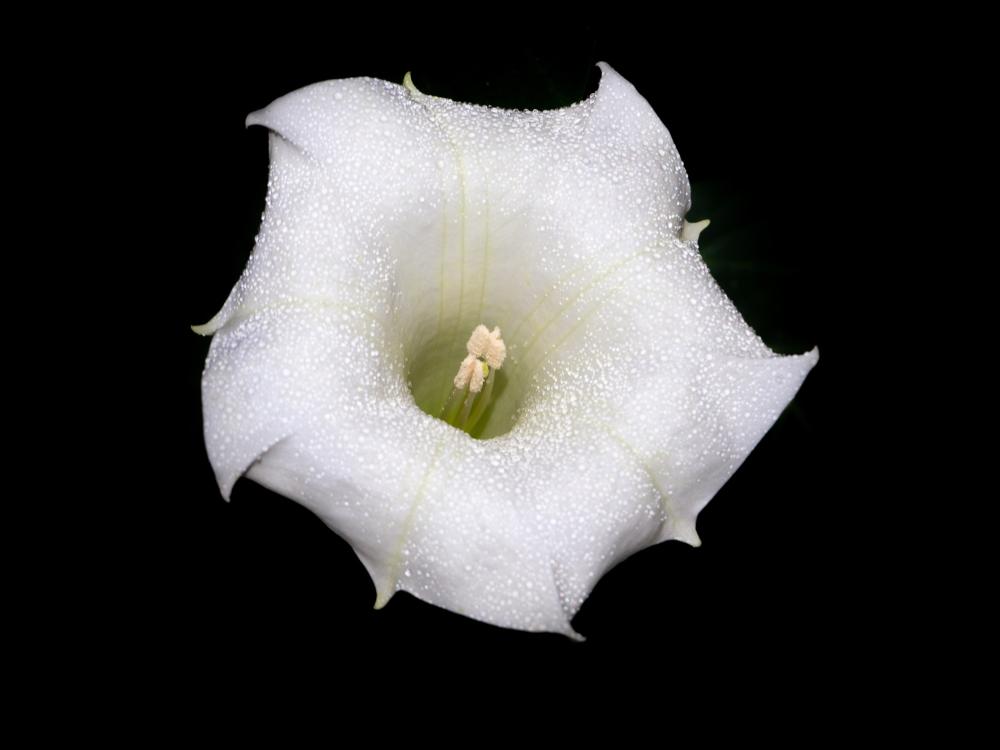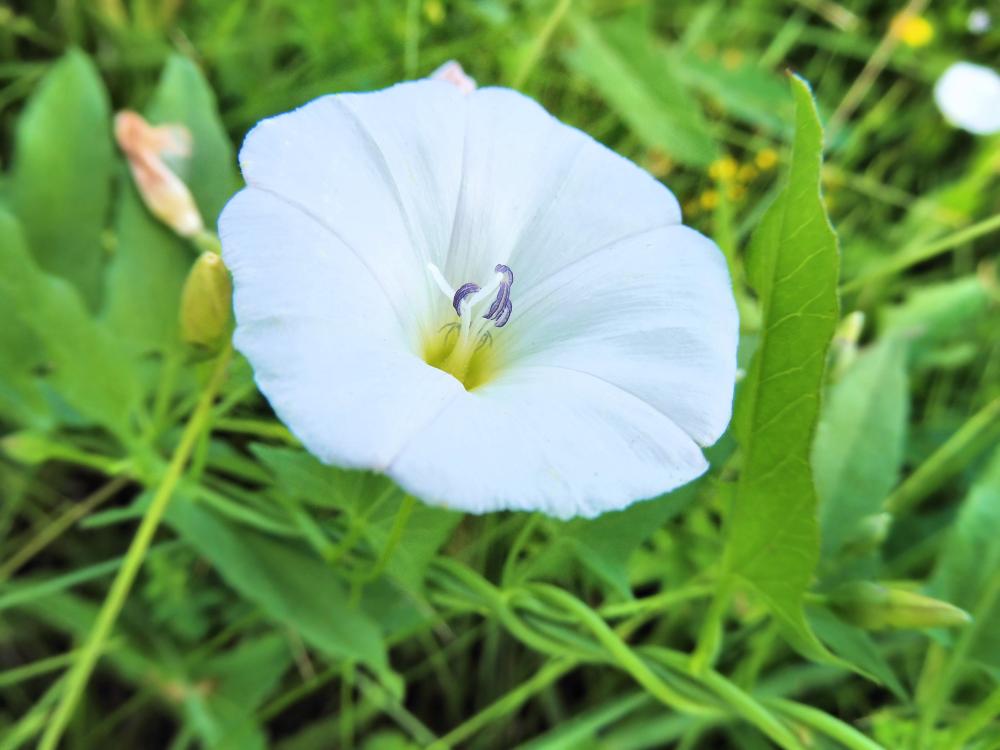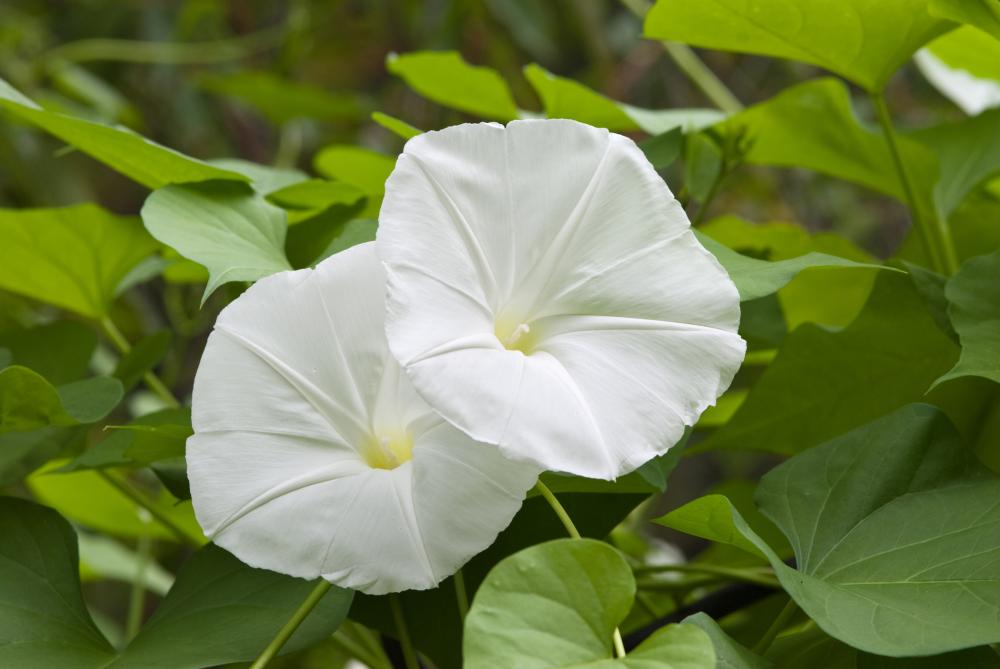How to Grow & Care for Moonflower Plants
The moonflower is a remarkable self-seeding plant with annual flowers that make your garden space look like a work of outstanding artistry. Even though the plant is toxic to humans, its blooms are colorful and produce an elegant fragrance during the night.
The perennial shrub is native to North America and a lover of tropical or subtropical regions. In this guide, we’ll check out some of the optimal growing conditions you need to consider when nurturing this flowering beauty.
Moonflower at a Glance
Moonflowers are perennial vines with a tender texture and are mostly grown for their incredibly looking blooms. They are a perfect type for landscaping and adding color to the garden. Other common names this bloomer goes by include moon vine, evening glory, and moon creeper. The dominantly cultivated moonflower is botanically known as Ipomoea alba and comes from the Convolvulaceae family. On average, you can expect it to reach anywhere between 10’ and 15’ feet tall.
During the night, the blooms tend to unfurl from their buds and stay open till the next morning. It’s best to grow moonflower plants in the spring once the frost period is over. So, are there moonflower varieties one could consider growing? That’s a question we get asked a lot anytime we write about blooming plants. After skimming through the internet, you’ll soon realize that there are a handful of night-blooming plants that are collectively referred to as moonflowers.
However, what I learned while researching about Moonflower plants is the two commonly cultivated varieties are Ipomoea alba and Datura innoxia. There are also high chances you’ll find the Ipomea violacea type being sold in most gardening stores and nurseries. The two dominant species have a potent resemblance, so it would be best to go in-depth and point out the distinct characteristics of each.
Datura innoxia: Compared to the Ipomoea alba, this type is significantly shorter. You’ll, however, notice some resemblance with the blooms. The variety has the traits of a perennial shrub. The blooms on the Datura innoxia don’t die and reproduce every day. All they do is fully reveal their luster once nighttime checks in. As it matures, some tiny gray hairs will cover the entire plant, making it have a grayish tone. The stems and foliage will remain green throughout the growing seasons.
Ipomoea alba: This type is ideal for growers living in a tropical or subtropical region. Others like to call it the tropical white morning-glory. It trails in a wild manner and can reach up to 90’ feet in length. To elongate to such magnitude, this moonflower would need a tree that it can use to climb. The flowers will blossom during the night and span to about 6’ inches in diameter. They have a tasteful fragrance and could survive the entire blooming season. However, once they close up, the blooms will die then reproduce. One downside of growing the Ipomoea alba is its overall lifespan can be notably short. You can overwinter the morning glory by growing it inside containers, then moving them indoors.
Moonflower Caring Tips
Flowering & Fragrance
You can expect the moonflower to bloom during summer or the fall season. The perennial vine produces white flowers with a pleasant fragrance. If you’re living in a subtropical region, it would be easy for the houseplant to bloom. The trumpet-shaped flowers usually stay open during the night, then fold up when the sun rises.
Soil Requirements
You won’t need to work with a sophisticated soil structure when growing this perennial bloomer. In fact, it can keep up with any soil type. The only thing to take note of is its drainage capacity. Soggy soil would lead to root rot. If the soil has a higher clay composition, then your potted plant is more likely to struggle with drainage issues. It’s best to use organic compost if you’re looking to make the soil organic-rich without hurting the plant’s foliage quality.
Since the flowering houseplant is accustomed to subtropical environments, you want to mulch the topsoil so it can retain some bits of moisture. Ideally, it should have a slightly acidic to neutral soil pH. If you’re growing your moonflower indoors using seeds, start it off in the growing season with a peat-based potting mix. Use containers that are at least 3’ inches deep and wide when sowing the seeds. They will need to stay in the soil for a period between six to eight weeks before the last spring frost checks in.
Make sure to lightly cover the seeds with a quarter layer of normal potting soil. Once sprouting begins to emerge, place the pots on a pebble tray filled with water to give them the optimal level of humidity. To raise the humidity a little bit further, you can cover the pots using a plastic bag. You also want to move the containers to a spot with enough bright, indirect light. Keep the soil evenly moist but not too soggy to avoid the effects of overwatering. Once every two weeks, you can add a new layer of organic compost to improve the overall nutritional composition in the soil.
Water
One thing you’ll outrightly notice about the moonflower is it prefers the modest ratio of moisture even during an active growing season. However, when germinating, you’ll need to constantly provide the seeds with enough moisture. Once the early sprouting stage is over, keep the soil evenly moist but make sure not to leave it soggy. If the soil remains drenched for too long, then it could lead to root rot. For an established moonflower, watering is only necessary when the soil has entirely dried out.
Light
Your moonflower will prefer to grow under the full sun. Therefore, you’ll need to place the growing medium in a spot that can receive between six and eight hours of direct sunlight. While it’s essential to provide some partial shade, too much of it could slow down the potential to produce flowers. At the same time, you want to protect the foliage from any intense heat that could burn it. When there’s low light, this perennial vine will experience a sluggish growth rate. You also need to avoid planting moonflowers near buildings or blocks that block access to direct sunlight.
Temperature & Humidity
After showing keen interest to learn all it takes to grow this subtropical plant, you probably know that it prefers to stick around a warm environment. For this reason, you’ll need to grow it somewhere with high temperatures and humidity. On the other hand, you can also treat it as an annual if you’re living in a colder region. However, you’ll need to wait till the temperatures are constantly upwards of 60 degrees Fahrenheit. The ideal temperature should be anywhere above 75 degrees Fahrenheit. Keep the soil moist at all times to cool the plant off if your region is facing intense heat or drought.
Fertilizer
Moonflowers can thrive without being fed. They’ll still have a high leaf growth rate. The downside is you won’t see them blooming aggressively as they would when boosted with a portion of fertilizer. You can go with organic compost if you’re looking to avoid the effects of using synthetic fertilizer. If you opt to use the commercial option, pick one that’s soluble and rich in phosphorus. Before using the fertilizer, make sure to dilute it at half its strength. It’s best to keep off fertilizer that has a high nitrogen composition as it will help in leaf growth but limit the production of flowers.
How to Propagate the Moonflower
It’s easy to reproduce moonflower plants using seeds. All you need is to harvest some from a mature vine. When collecting the seeds, check if they’ve dried up completely. Before the final forecasted frost date in the spring, you’ll need to prepare the seeds for sprouting. Start them off indoors for a period between four to six weeks. To break the outer coating, you can soak the seeds inside warm water overnight.
You can choose to plant the moonflower seeds outdoors after the last frost period is over if you’re finding transplanting to be labor-intensive. Moonflower doesn’t like to have its roots tampered with, so you want to consider planting the seeds inside a biodegradable peat-based pot that you can bury in your outdoor gardening space. After a week the seeds will be in an active germination phase. Keep the temperature in the range between 65 and 85 degrees Fahrenheit during this period.
You also need to provide the seedlings with enough air circulation by loosening up the soil and spacing them out at least 6’ inches apart. Besides seeds, you can try propagating moonflower using cuttings. Summer is usually the best season if you’re looking to use this method. Wait till the outdoor temperature is consistently warm, then move the seedlings outdoors so they can get accustomed to long hours of direct sunlight.
Common Pests & Diseases
Diseases
While taking care of houseplants, it’s typical to deal with a couple of pests or diseases that have the potential to ruin your plant’s overall ornamental appeal. Since this plant prefers an environment with some bits of moisture in the air, it’s highly likely to struggle with black rot. It’s a bacterial disease that emerges in areas with high humidity. If your moonflower is suffering from this condition, you can treat it by loosening up the soil and splitting the vines to allow more air circulation. Keep the plant dry during the night and avoid overhead watering at all costs.
Pest Problems
There are chances you’ll probably have to deal with aphids at some point during this plant’s lifetime. These bugs like to suck juices from the foliage of moonflower plants and leave a sticky residue that resembles droppings from insects. You can wash the pests off using a garden hose or spray insecticidal soap on the affected areas. Beneficial insects like lady beetles or wasps could also help get rid of aphids. You also need to watch out for Japanese beetles. These pests have metallic green bodies with wing covers that have a copperish color. They tend to poke holes on leaves and buds, leaving the foliage looking like a skeleton.
You can pick the beetles manually or use soapy water to wipe off the affected areas. When during the routine grooming, lookout for any leaf miners on the underside of leaves. During their larval stage, the pests will damage the plant’s overall appearance and leave some non-uniform lines on the leaves. If you notice miniature webs on the foliage, then your moonflower could be harboring some spider mites. You can also use insecticidal soap to get rid of these pests.
Moonflower Companion Plants
There are a bunch of growers who like to couple up the moonflower with other bloomers, especially those whose petals open up during the day. If you’re this type of grower, we have a few preferences for you. You can try growing moonflower alongside cypress vines. They’re often treated as annuals and produce some bright red blooms. Another option in the same genus is the cardinal climber (Ipomoea × multifida) which has scarlet-like blooms with red, yellow, or white throats. For growers looking to have an all-white garden that glows during the night, the star jasmine would be a perfect companion plant.
Moonflower Care: FAQ
Why are there yellow lesions on the leaves?
If you spot some yellow lesions on the edges of the leaves, it could mean that your moonflower is suffering from black rot. Over time, the bacterial disease will lead to the dropping of leaves if you don’t treat it promptly. One way to keep this from happening is working with the modest moisture level and spacing out the seedlings when planting them.
Can I grow moonflowers in pots?
Yes, it’s possible. You can plant the seedlings inside pots just the same way you would in the ground. The most essential thing to do is to space the seedlings out. You also need to make a provision for a trellis inside the pot so the vines can climb with ease.
Why are my seedlings dying?
The condition is commonly known as damping off. It could happen even to healthy seedlings without showing any early signs to warn you. To prevent the seedlings from dying, avoid overcrowding or overwatering them during the germination phase. Enough air circulation should also help resolve the issue.



